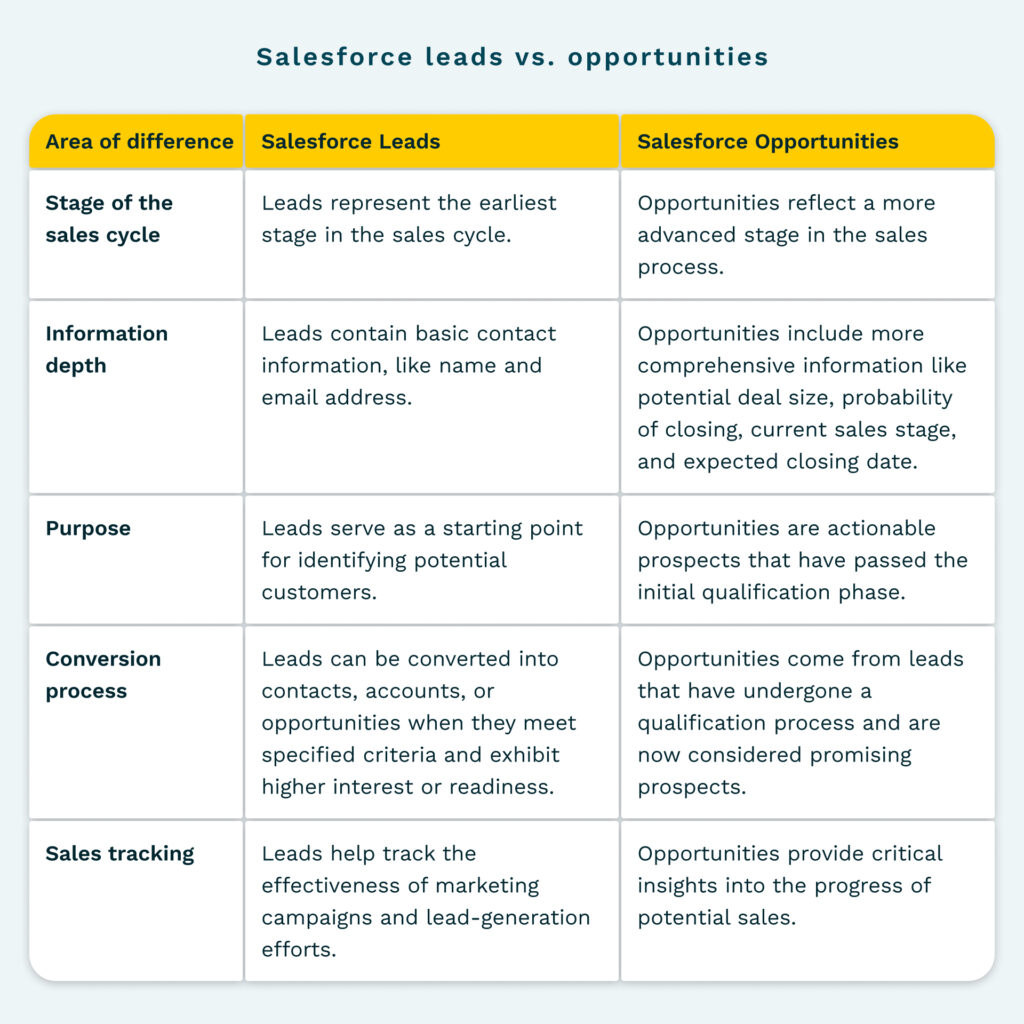Salesforce leads and Salesforce opportunities. These terms might be the first to welcome you as you enter the Salesforce world.
However, comprehending these terms is nothing short of vital. This article takes a deep dive into these two crucial terms within Salesforce to help you understand their roles, distinctions, and tips to make the most of them.
We will also explore the conversion process and understand when to convert a lead into an opportunity and why it matters.
Let’s begin.
What is a Salesforce Lead?
A lead is the initial stage in the customer acquisition process in Salesforce. It represents a potential customer or business entity interested in your product or service.
However, their interest has yet to evolve into a concrete sales opportunity. Leads are often individuals or organizations that have interacted with your company somehow. Some common examples include filling out a contact form on your website or attending a webinar.

Let’s consider a software company, XYZ Tech, offering a project management tool. They launched a marketing campaign, and as a result, several professionals expressed interest in the product by signing up for a free demo on the website.
At this stage, these individuals are considered leads within Salesforce. The company has their basic information, like name, email address, and the source of their interest (the marketing campaign), recorded in the CRM system.
However, being leads, these individuals have yet to reach the point where they are ready to purchase. They may need further nurturing, information, or engagement to evaluate whether XYZ Tech’s project management tool aligns with their needs.
As XYZ Tech’s sales and marketing teams interact with these leads, providing insights and addressing queries, some may gradually progress to the next stage: becoming opportunities.
What is an Opportunity in Salesforce?
An opportunity reflects a distinct stage in the sales pipeline of the Salesforce CRM ecosystem. At this stage, a lead or potential customer has advanced beyond initial interest and is now a qualified prospect with a real chance of making a purchase.
Opportunities are critical in tracking and managing the sales process, as they provide a structured framework for sales teams to pursue and close deals. Each option includes the potential revenue, probability of closing the deal, sales stage, and expected closing date. All these aspects provide a comprehensive overview of the sales potential associated with a prospect.

To illustrate the concept of better, let’s return to our example with XYZ Tech. After some time nurturing the leads generated from their marketing campaign, the sales team at XYZ Tech identified a lead named John Smith, who has shown interest in their product. John has held multiple discussions with the sales representatives and attended a product demonstration. He has also expressed his intent to implement the software for his organization.
At this point, John transitions from being a lead to becoming an opportunity within Salesforce. The CRM system may now contain the following information about the potential sale:
- Estimated deal value,
- The stage of the sales process (e.g., “Proposal Sent”)
- The probability of closing the deal based on historical data and the current circumstances (e.g., 70% chance of closing)
- The expected closing date (e.g., within the next 30 days).
Salesforce Leads vs. Opportunities
Understanding the distinctions between leads and opportunities is critical to managing and nurturing potential customers through the sales cycle. While both play pivotal roles in customer relationship management, they serve different purposes within the sales process. Here are some critical differences between Salesforce leads vs. opportunities.

Difference 1: Stage of the sales cycle
Leads
Leads represent the earliest stage in the sales cycle. They are potential customers who have shown initial interest but have yet to be fully qualified or ready for direct sales engagement.
Opportunities
Opportunities reflect a more advanced stage in the sales process. They indicate that a lead has progressed to the point where there is a genuine potential for a sale.
Difference 2: Information depth
Leads
Leads contain basic contact information, like name and email address. It also includes the source of their interest. They may also have limited data on their specific needs.
Opportunities
Opportunities include more comprehensive information. They include details on the potential deal size, probability of closing, current sales stage, and expected closing date. The depth of data helps track and forecast revenue.
Difference 3: Purpose
Leads
Leads serve as a starting point for identifying potential customers. They require further nurturing and qualification to determine if they are genuinely interested and their needs align with the offered product or service.
Opportunities
Opportunities are actionable prospects that have passed the initial qualification phase. Sales teams focus on opportunities to pursue a sale and close deals actively.
Difference 4: Conversion process
Leads
You can convert leads into contacts, accounts, or opportunities when they meet specified criteria and exhibit higher interest or readiness.
Opportunities
Opportunities come from leads that have undergone a qualification process and are now considered promising prospects. They don’t convert into other Salesforce entities but are worked upon to reach a successful sale.
Difference 5: Sales tracking
Leads
Leads help track the effectiveness of marketing campaigns and lead-generation efforts. This is because they represent the starting point of customer interaction.
Opportunities
Opportunities provide critical insights into the progress of potential sales. They help sales teams prioritize deals and forecast revenue more accurately.
When Does a Lead Convert into an Opportunity?
The decision to convert a lead into an opportunity in Salesforce is critical in the sales process. It requires careful consideration and strategic judgment.
While the specific criteria for conversion may vary, here are some best practices that should guide this decision-making process.
1. Qualification and engagement
Before converting a lead, assess its level of qualification and engagement. Has the lead demonstrated a genuine interest in your product or service? Have they engaged in meaningful interactions with your sales or marketing teams? Qualification may involve the lead’s budget, authority, need, and timeline (BANT).
2. Information completeness
Ensure the lead’s profile contains sufficient information to proceed with the conversion. It includes accurate contact details, organization information, and relevant notes about their preferences. Incomplete or inaccurate information can hinder the sales process and lead to misunderstandings.
3. Lead scoring
Implement a lead scoring system to assign numerical values to leads based on their behavior and engagement. Leads that reach a predefined score threshold may be prime candidates for conversion into opportunities, indicating a higher likelihood of closing a deal.
4. Intent signals
Consider the lead’s actions and intent signals. Have they requested a product demo, requested a quote, or initiated a trial period? Such actions can be strong indicators of readiness to move into the opportunity stage.
5. Sales team feedback
Solicit input from the sales team to gauge their assessment of the lead’s readiness. Their insights and interactions with the lead can provide valuable context.
FAQs
- What is the difference between a lead and an opportunity?
A lead represents a potential customer with an initial interest in your product or service. However, they have yet to reach a stage ready for direct sales engagement. Leads often have basic contact information and may require further nurturing and qualification.
On the other hand, an opportunity signifies a more advanced stage in the sales process. It represents a prospect who has moved beyond initial interest and is actively being pursued for a potential sale. Opportunities include estimated deal value, the probability of closing, and an expected closing date.
- What is a lead in Salesforce?
In Salesforce, a lead is a record that represents a potential customer or business entity that has expressed interest in your product or service. Leads contain basic contact information, like name and email, along with details about their source of interest. Leads are the initial stage in the sales cycle and require further nurturing and qualification for direct sales engagement.
- Can we create an opportunity without a lead in Salesforce?
Yes, creating an opportunity in Salesforce without a lead is possible. While leads often serve as the starting point for potential customer interactions, you can also create opportunities independently. For example, suppose your sales team has identified a possible sales opportunity through a referral or a direct inquiry. In that case, you can create an opportunity record directly in Salesforce to manage and track the sales process.
- What are the benefits of leads in Salesforce?
Leads in Salesforce offer the following benefits.
- Efficient lead management
Leads provide a structured way to manage potential customer interactions, ensuring inquiries are appropriately documented and tracked.
- Nurturing potential customers
Leads allow businesses to nurture potential customers by providing them with relevant information and gauging their readiness for a purchase.
- Lead source tracking
Salesforce leads help track the effectiveness of marketing campaigns and lead generation efforts, enabling businesses to allocate resources to the most successful lead sources.
- Streamlined sales process
Salesforce helps streamline the sales process, allowing sales teams to focus on prospects with genuine sales potential.
Salesforce Leads vs. Opportunities: Bottomline
Successful CRM management extends beyond understanding terms; it hinges on effective utilization. When you tailor your Salesforce setup to align with your business needs, remember to create a seamless lead-to-opportunity workflow and establish clear criteria for conversion.
Foster collaboration between your sales and marketing teams to ensure improved customer management. Remember to leverage Salesforce’s reporting and analytics tools to gain insights into the sales process.
Implementing these practices will help you maximize the power of Salesforce and elevate your organization’s efficiency in customer relationship management.








